- News
- Reviews
- Bikes
- Accessories
- Accessories - misc
- Computer mounts
- Bags
- Bar ends
- Bike bags & cases
- Bottle cages
- Bottles
- Cameras
- Car racks
- Child seats
- Computers
- Glasses
- GPS units
- Helmets
- Lights - front
- Lights - rear
- Lights - sets
- Locks
- Mirrors
- Mudguards
- Racks
- Pumps & CO2 inflators
- Puncture kits
- Reflectives
- Smart watches
- Stands and racks
- Trailers
- Clothing
- Components
- Bar tape & grips
- Bottom brackets
- Brake & gear cables
- Brake & STI levers
- Brake pads & spares
- Brakes
- Cassettes & freewheels
- Chains
- Chainsets & chainrings
- Derailleurs - front
- Derailleurs - rear
- Forks
- Gear levers & shifters
- Groupsets
- Handlebars & extensions
- Headsets
- Hubs
- Inner tubes
- Pedals
- Quick releases & skewers
- Saddles
- Seatposts
- Stems
- Wheels
- Tyres
- Health, fitness and nutrition
- Tools and workshop
- Miscellaneous
- Tubeless valves
- Buyers Guides
- Features
- Forum
- Recommends
- Podcast
feature
 BOTY201617endurance-img.jpg
BOTY201617endurance-img.jpgroad.cc Sportive and Endurance Bike of the Year 2016-17
The long distance road bike market is one of the most competitive in cycling with continually developing technology designed to improve comfort and performance, and here are the very best models that we’ve tested on road.cc over the past year.
This category covers road bikes that are designed to provide more comfort than traditional race bikes while retaining a performance dimension. Some manufacturers describe these models as sportive bikes, some call them gran fondo bikes, others call them endurance bikes.
The one feature that unites all of the bikes here is that they’re designed to be ridden long distances without some of the stresses and strains associated with a low and stretched riding position. Manufacturers tend to add height to the head tube and take a little length from the top tube to make the riding position a little more upright, meaning less chance of aches in your lower back and neck. Some brands make the ride position much more relaxed, others tweak it just a touch – there’s no standard approach.
An endurance bike also needs to provide a smooth ride. Bumps and road buzz not only affect the ride quality, they can lead to fatigue, so endurance bikes need some means of nullifying them. Manufacturers like Trek and Specialized include elaborate frame and fork features to improve the ride while other brands make the seatstays very slim, for example, or spec a skinny seatpost to allow a degree of up/down movement at the saddle.
The ability to take wider tyres is a must. The most common tyre width for road racing is 25mm these days. You’ll want the option of going to 28mm and beyond on an endurance bike so that there’s a larger cushion of air between you and the road surface.
Most of the bikes here are built around carbon-fibre frames, although aluminium and steel are represented too, and most are equipped with disc brakes. That’s not because we’ve intentionally selected disc brake bikes to review, it’s because that’s the way the market has taken us. Rim brakes aren’t going to be consigned to the great parts bin in the sky any time soon but discs are certainly in the ascendency and that’s reflected here.
Not everyone wants to fit mudguards but if you do the relevant eyelets will come in handy. Some frames have them, some don’t.
Right, let’s take a look at our top 10.
10. Bianchi Intenso Disc £2,500
The Bianchi Intenso Disc is a comfortable endurance bike that offers a well-balanced ride and consistent braking in all weathers (the 2017 version of this bike comes with Fulcrum Racing Sport Disc Brake wheels rather than the DT Swiss R24 Spline wheels fitted here, and it's priced £2,600).
The Intenso Disc is a good bike for racking up the miles whatever the conditions. The riding position is performance orientated but a couple of clicks back from full-on aggressive, the components score highly for reliability, and you get neutral, well-behaved handling here.
Bianchi provides more comfort through the shaping of the fork and the snaking rear triangle, along with Kevlar inserts in those areas, provide improved shock absorption and adherence to the road.
The Intenso Disc is stable at speed without any twitchiness, and it corners beautifully thanks to its well-balanced setup. If you do find that you've overdone the speed going into a bend, the Shimano BR-RS505 hydraulic disc brakes – essentially 105 level – will get you out of trouble.
Why it’s here It’s a comfortable, reliable endurance bike that provides excellent braking in all weathers
9. Cinelli Nemo Tig Athena £2,549.99
Cinelli's Nemo Tig is a high quality steel framed road bike that puts in a strong performance. It's responsive and fun to ride, with great balance and poise on both the ups and the downs. The only real downside is the weight, but if you're after a great-looking and riding bike for general road riding, rather than something to race on, this is well worth considering.
From the off, the Cinelli is a fun bike to ride. It feels composed over the rougher tarmac without feeling detached, and on smoother surfaces it’s happy to zing along quietly and without fuss.
It's an engaging bike to ride, and certainly gives you that lively feel you want from a steel bike without ever feeling vague. The front end is stiff and direct in the turn: this is a bike that's a lot of fun to point down a fast descent, even on a variable surface. On open bends with good visibility, when it’s possible to point the bike at the apex and hold your speed, it never misses the mark. It's an assured descender.
The stiff alloy Cinelli Vai stem and bar help there, without being so stiff as to render the bike uncomfortable. It's designed to be comfy over long distances; it doesn't have the surface-taming qualities of something like a Trek Domane or Specialized Roubaix, but it does a good job of holding the middle ground between super-stiff race bikes and comfort-orientated endurance bikes.
On punchy climbs and sprints, when it's time to get out of the saddle and give it the gas, the Nemo is excellent fun. It's not as stiff at the back as a big-section carbon frame, but it's not so flexy as to cause any issues.
Why it’s here It’s a high quality steel Sunday bike with an involving ride and a classic look
8. Wilier GTR Team Disc Endurance £2,699
The Wilier GTR Team Disc Ultegra is a quick and smooth endurance bike that offers the assured performance of Shimano's hydraulic disc brakes.
The Wilier feels a lot more performance orientated than many other endurance bikes out there. Some manufacturers sacrifice frame stiffness in their quest for comfort, but the GTR Team Disc Ultegra has the feel of a race bike when you turn the power up a few notches; the whole central area of the frame holds firm against your best efforts.
You're probably not going to spend much of your time flat-out sprinting on a bike like this, but you're likely to lay it all on the line occasionally, even if you're just racing your mates to the cafe stop, and it's good to know the frame isn't going to twist and bend when you want to whip your muscles into life.
You pay a slight weight penalty for the disc brakes but the GTR Team Disc Ultegra still comes in at a reasonable 8.34kg (18.4lb). You can get a bike that's considerably lighter for this kind of money but weight isn't everything – far from it, it's just a small part of the overall package.
The Wilier climbs well and Shimano’s BR-RS805 hydraulic brakes offer very impressive performance.
It offers a comfortable ride with an endurance geometry, a frame that sieves out buzz and a skinny seatpost. If you want more cushioning you can swap Vittoria's 25mm wide tyres for 28s – there's enough frame and fork clearance.
Why it’s here This is a comfortable race-leaning endurance bike with the all-weather performance of Shimano's hydraulic discs
7. Vitus Zenium SL Disc £1,299.99
Vitus has added a new, lighter, more comfortable frameset for the Zenium SL over the pretty damn good VR model. The 2016 version offered a Shimano 105 groupset, full-carbon fork, TRP Spyre mechanical disc brakes and a Fulcrum Racing 5 wheelset, for a £1,299.99 outlay. For 2017 the spec is altered and includes Shimano hydraulic disc brakes and FSA Team 30 wheels for £1,249.99.
The Zenium SL does still have a stiff ride, but you might like that. It's good to get on board something that can just be smashed about a bit and ridden hard.
The Zenium isn't uncompromising – you can ride 100 miles on it at a steady pace, ride a sportive, or a long club ride – but it responds to a bit of aggression, an out-of-the-saddle effort up that short, sharp climb, the sprint for the village sign, nailing that Strava segment, that sort of thing.
The Zenium SL has an aluminium frame made from a 6066-T6 alloy, as opposed to the lower priced models in the range which use a 6061-T6 grade. The 6066-T6 offers a higher strength to weight ratio, which means Vitus can cut a bit of weight from the frame by using less material for the same stiffness. It also seems to be a little more forgiving.
Out on the road the Vitus has a kick. Stamp on those pedals and it'll respond through the head tube and bottom bracket junctions, those places where you want stiffness and total efficiency.
The Zenium's geometry is slightly more relaxed than a race bike’s but only slightly. The steering is direct and you don't get any chatter or diving from the full-carbon fork when you brake.
Yes, it's maybe a touch on the harsh side, but if you're the sort of rider who likes to go hard, as if you're racing without actually signing on, plus you want the all-round advantages of disc brakes, look no further.
Why it’s here It’s a very good semi-race bike that responds well to hard efforts
6. Trek Domane SLR 6 £3,600
There are few endurance bikes as comfortable as the new Trek Domane SLR. It is incredibly smooth, filtering out the most severe vibrations on all sorts of rough roads, gravel tracks and cobblestones.
The headline news is a two-pronged approach aimed at delivering front end compliance that better matches the rear IsoSpeed decoupler (see below), a novel development in the original bike that provides a range of comfort-boosting deflection.
A common complaint with the original Domane centred around the front end feeling much stiffer than the compliant rear end.To solve this, Trek has integrated an IsoSpeed decoupler into the head tube, allowing a specially shaped carbon fibre steerer tube to bend slightly between the two headset bearings. We're only talking a very small amount of deflection, with rider weight and stem length being a factor in the bending range. Trek has also developed the new IsoCore handlebar. Within the carbon fibre layup is a layer of rubber that allows the handlebar to dissipate some of the high-frequency vibrations.
The other big news is the adjustable rear IsoSpeed decoupler, which now employs a split seat tube design, first seen on the Madone aero road bike. In the new design, the front section of the split tube is attached at the top tube like a regular seat tube, which creates a stiffer frame, with only the rear section independent. The amount of deflection is also adjustable – loosen a single bolt and slide the dividing lever into the desired position.
The Domane SLR damps the vibrations and manages to isolate you just enough from the most severe bumps and dips, providing a floaty feeling without completely detaching you from what is happening under the tyres. Yet the Domane SLR doesn't feel baggy or loose, it's still direct and responsive if you like to ride hard and expect the bike to deliver the sort of performance that a race-bred carbon bike should.
Why it’s here The new Domane is smoother and more comfortable than the original, and fast and fun as well
5. Canyon Endurace CF SLX 9.0 SL £5,099
This bike (now £5,199 in a revised spec) offers a wonderfully smooth and comfortable ride with fast and engaging handling to indulge all those who like to ride quickly. It benefits from hydraulic disc brakes and thru-axles for improved braking performance in all conditions.
The Endurace CF SLX is hugely impressive in terms of ride and performance. It's the smoothness that first grabs you. The VCLS 2.0 seatpost provides a huge range of rearward deflection at the saddle – you can actually see the saddle moving underneath you when you look between your legs. It's slightly disconcerting at first but you quickly get used to it. It works well, filtering out vibrations from poorly surfaced roads while also dealing with bigger impacts such as potholes or cattle grids.
Comfort is helped by the fact that Canyon has lowered the seat clamp inside the frame. This allows more of the seatpost to flex back and forth, ramping up the available deflection. Adjusting the saddle angle is a bit of a fiddle – you have to remove the post from the frame – but it's a set-and-forget job.
The distinctive one-piece carbon fibre handlebar is designed to reduce drag and it is compliant enough to smooth the ride.
The Endurace CF SLX is one of the raciest endurance bikes we’ve reviewed on road.cc. All endurance bikes are relaxed in comparison to the race bikes they're loosely based on, some more so than others, but the Endurace is really not that high at the front. You can still get quite an aggressive position if you like to hunch over the bar and get aero.
Its short wheelbase gives it a nimbleness that's lacking in some, while the increased fork rake further contributes to the direct and agile manners it displays in willing hands.
Why it’s here Wonderfully smooth and comfortable endurance disc road bike with plenty of pace on tap when you want it
4. Orro Gold STC Disc Ultegra 11-speed £2,199.99
The Orro Gold STC Disc Ultegra is a gran fondo bike that's as lively and responsive as most road race bikes, with hydraulic disc brakes and plenty of comfort thrown in.
The thing that most surprised us about the Orro Gold STC is the level of frame stiffness on offer here when you start to push hard. You might expect it, as a gran fondo bike, to be a little more squidgy than an out-and-out race bike when you get out of the saddle, but that's not the case. Far from it. The oversized bottom bracket area held almost completely solid despite all of my best efforts to send it east and west on climbs and sprints.
The same is true of the rest of the frame. The Orro Gold STC's head tube and fork resist unwanted movement. Haul on the bar and there's no mushiness at all, and the cornering precision is spot on.
Orro puts the frame stiffness down to its spread tow carbon made from fabrics that are thin and lightweight. The carbon fibre is arranged in flat and wide tapes that are woven together.
The Orro Gold STC Disc differs from a road race bike in its geometry. You get a riding position that's relatively easy on your back but still performance orientated.
The frame and the slim 27.2mm diameter 3T Stilo Pro Setback seatpost filter out road buzz well, aided and abetted by 25mm wide Continental Grand Prix tyres.
The Shimano RS805 hydraulic disc brakes allow you to moderate your speed with absolute precision and there's never an excuse for locking up.
Why it’s here This is an excellent gran fondo bike: quick and responsive with the assurance of hydraulic disc brakes
3. Specialized Roubaix Expert £3,200
For most of the Roubaix's existence Specialized has employed small elastomer inserts called Zertz, placed in the fork blades and seatstays. With this new 2017 bike, the Zertz have been binned and replaced in the front by the Future Shock, a small spring housed inside the head tube providing 20mm of movement, and Specialized's existing CG-R 27.2mm seatpost contained inside a wide diameter seatpost and a dropped seatclamp, to allow more deflection.
There's no doubt about it, the Future Shock works. It delivers a smoother ride than the old Roubaix SL4 and it feels smoother than other endurance bikes such as the Trek Domane SLR and Canyon Endurace CF SLX. It's really good at reducing the high-frequency vibrations normally felt through the handlebar.
Because the Future Shock is positioned between the stem and frame, it's only supporting your upper body weight. That means it's not soft and bouncy – it's definitely no pogo stick – but is instead quite firm, yet soft enough to react to the smallest road buzz very well.
There's no strangeness when sprinting or climbing out of the saddle, movements that put more weight into the handlebar. When you're leaning heavily on the bar during a steep climb there is a bit more movement compared with seated pedalling, but get out of the saddle and give it the beans in a full powered sprint and there's no feeling that you're losing any precious speed.
There are a few niggles. While it damps vibrations from most of the roughest roads and deals with smaller bumps and rounded impacts very well, it's not so successful with square edge impacts like exposed manhole covers, but the feedback through the handlebar is certainly softer than that of other bikes.
The Roubaix isn't just about the Future Shock. To combat rear-end impacts, Specialized has used its existing CG-R seatpost, a 27.2mm diameter carbon fibre post topped with a Zertz head. This means that seated comfort is fantastic with no impacts finding their way through to your butt.
Why it’s here Light, stiff and comfortable, the new Roubaix with its FutureShock delivers an impressive ride
2. Cervélo C5 Dura-Ace Disc £6,199
The C5 is designed to appeal to the growing number of cyclists who want a bike that provides comfort and stability with the control afforded by hydraulic disc brakes, and the ride quality is is sublime. It provides a stunning level of comfort and smoothness, while the handling lets you exploit the performance that the carbon fibre frame, with its tapered head tube, wide bottom bracket and thru-axles, offers.
The damping provided by the frame and fork removes almost all the vibrations and judders generated from riding over a rough surface, whether a poorly maintained country lane or gravel path.
What's really impressive is just how well matched the fork and frame are, both equally damped and ensuring your hands and bum are isolated from the worst of the vibrations and impacts.
But it's not a soft bike, oh no. There's enough stiffness to ensure the Cervélo has plenty of get-up-and-go when you want to push on at speed. It's responsive and taut when being ridden aggressively and at pace, and is rapid enough to keep up with the fast group in the evening chain gang, should you indulge in such things. Dial back the pain and suffering, and it's pliant enough to look after you on an all-day adventure or sportive with a multitude of road and off-road surfaces.
The handling is a delight. As you turn into a corner, the steering is well measured, with the slacker head angle, long wheelbase and lower bottom bracket combining to create a superb stability.
When it comes to adjusting your speed, the powerful hydraulic disc brakes provide incredible control.
Why it’s here Fast, stable, predictable and balanced, Cervélo's new C5 is a class leader
1. Whyte Wessex £2,150
Fast and sporty with all the practicality and dependability of hydraulic disc brakes, wide tyres and space for full-length mudguards, the carbon fibre Whyte Wessex is a bike that is up to the task of taking on the roughest roads and toughest weather.
Racing aside, it's all the bike you really need for year-round riding in the UK, fast enough for sportives and pacy training runs, comfortable and reliable for grinding out winter miles, and at home on longer commutes.
Whyte set itself the goal of creating the most dependable, reliable, comfortable bike for surviving the worst conditions, and it it has ticked all those boxes. This is a very impressive bike.
Rolling along country lanes, the bike benefits from a stable and surefooted balance, a result of a long wheelbase. The steering is predictable and relaxed. Out of the saddle and up steep and long ascents, the Wessex climbs authoritatively, the front end displaying a crispness with no hint of flex from the fork or rub from the disc brake.
As you settle into a steady rhythm, the 30mm-wide Schwalbe S-One tyres roll with surprising pace. Run at a low pressure, these really take out the hard edges of some of the more badly surfaced roads.
When the pace picks up the Wessex displays the direct handling of a race bike, nimble when asked to perform sudden changes in direction. The get-up-and-go response of the bike is incredible and it’s as comfortable as you like if a relaxed cruising speed is your highest ambition for a cycle ride.
There is just one model of Wessex available and it comes with a Shimano Ultegra 6800 11-speed drivetrain with an FSA Gossamer Pro EVO-386 50/34 compact chainset and an FSA Evo bottom bracket.
The brakes are Shimano ST-685 levers, containing mechanical shifting internals with hydraulic brake levers, operating BR-805 flat mount callipers. It's all solid and dependable equipment, smooth shifting and powerful brakes.
The Whyte Wessex is very much a bike of the moment. It meets the needs of British cyclists wanting a dependable and reliable bike for riding in all weathers, and the equipment is smartly chosen to ensure it delivers brilliant performance and reliability. For many people, this is going to be the perfect British road bike.
Why it wins This bike is perfect for year-round British road cycling
Mat has been in cycling media since 1996, on titles including BikeRadar, Total Bike, Total Mountain Bike, What Mountain Bike and Mountain Biking UK, and he has been editor of 220 Triathlon and Cycling Plus. Mat has been road.cc technical editor for over a decade, testing bikes, fettling the latest kit, and trying out the most up-to-the-minute clothing. He has won his category in Ironman UK 70.3 and finished on the podium in both marathons he has run. Mat is a Cambridge graduate who did a post-grad in magazine journalism, and he is a winner of the Cycling Media Award for Specialist Online Writer. Now over 50, he's riding road and gravel bikes most days for fun and fitness rather than training for competitions.
Latest Comments
- ktache 6 hours 46 min ago
The batteries were not the easiest to find, and the brackets broke easily. The switch was far better than the D cell quick release ever readys that...
- ktache 7 hours 12 min ago
There are people out there who will make you the belt out of your old tyre.
- chrisonabike 7 hours 13 min ago
Furry dice and an air freshener for your helmet.
- AidanR 7 hours 26 min ago
Looking at the pictures in the linked article, the bikes aren't actually inconsiderately parked. The only issue is that they're on private property...
- Simon E 8 hours 1 min ago
Ah yes, those are hopefully not the 'master craftsmen' that has constructed a wide range of shoddy Italian cars and motorbikes over the years with...
- Simon E 8 hours 23 min ago
A SuperSix is definitely not an all-rounder....
- JLasTSR 8 hours 30 min ago
Since most of.my clothes come.from.charity shops.or the eBay nearly for.nothing clothing section I don't tend.to.worry if they wear out, I am also...
- chrisonabike 9 hours 15 min ago
Just get them to walk a treadmill - or better, ride exercise bikes to power path lighting.
- AidanR 9 hours 51 min ago
So his advisers were trying to move funds around to cover losses, but in a way that needlessly created additional liabilities? It would have been...
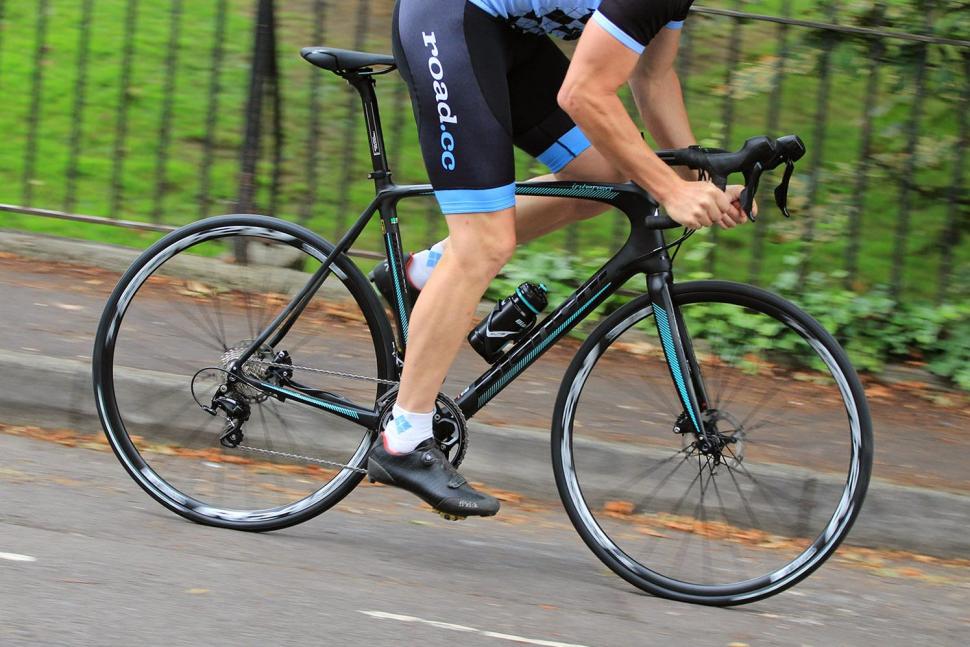


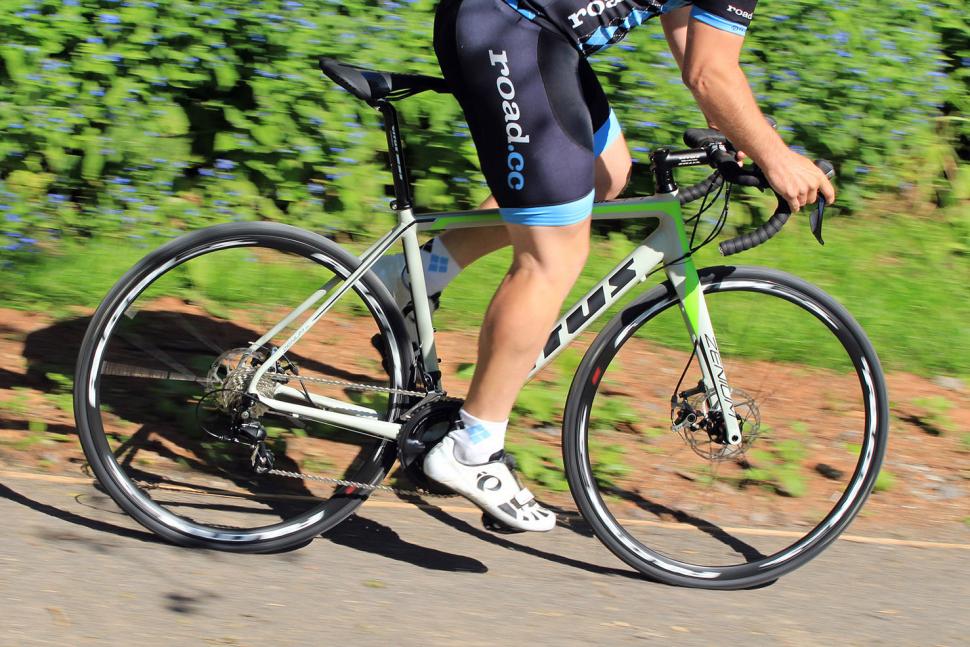
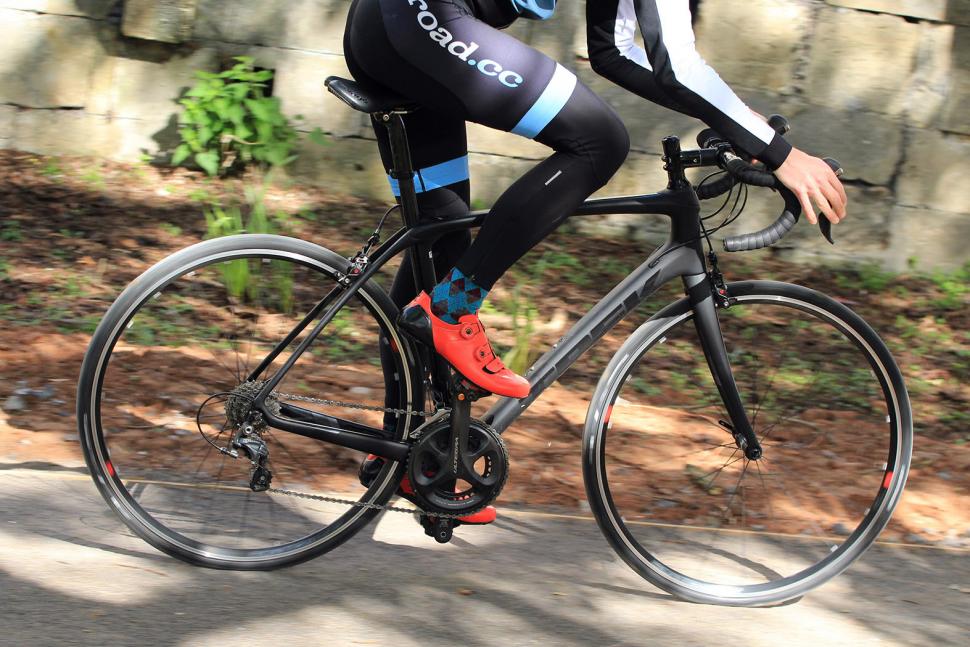

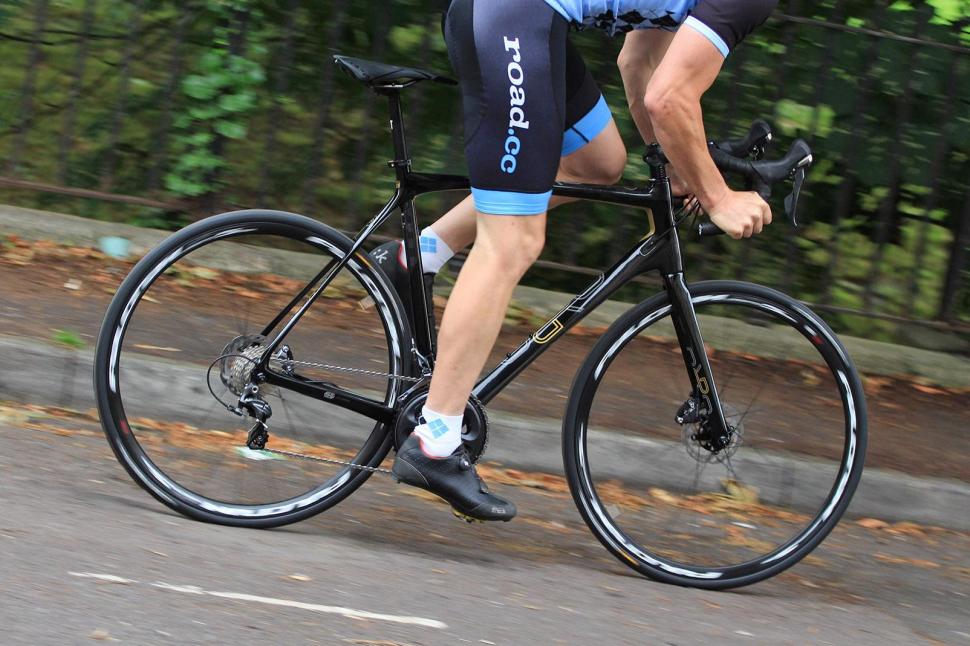
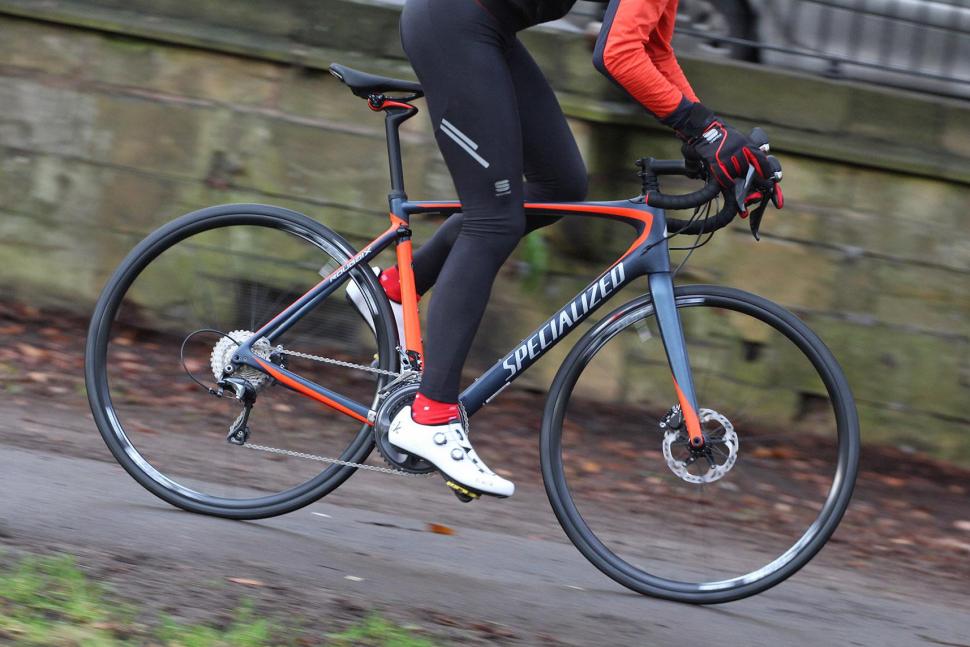
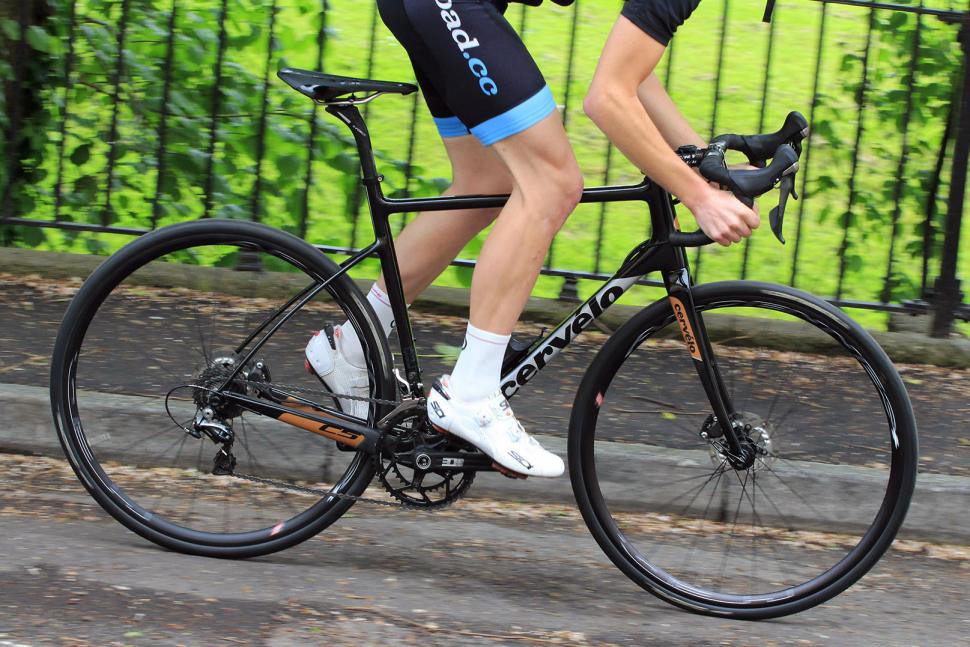

Add new comment
36 comments
My anecdote: descended Furkapass in a few degrees of pissing rain. Half way down my hands stopped working, so did the SRAM Red calipers with Swisstop pads on new alu rims - so a descent that should have taken maybe 20 mins took nearer an hour, as being on the brakes constantly to keep the rims free of water made for a nightmare descent. The rim/block combo - arguably the best in the industry, certainly on par with D-A or at the least Ultegra - just could not handle the water.
AND:
a friend just wrote off a pair of fairly decent Fulcrum wheels after a single season of riding. £400 worth. Was using highly regarded Kool-Stop Salmon pads, set up by me. He now budgets that much, each year, as part of 'riding' in all weathers.
So I utterly refute your assertion that 'calipers are damn cheap to maintain'. They aren't. You need new cables every thousand miles or so, and on a roadbike, that means lifting the bartape too. You need new pads likewise. You need new wheels every 3-5000 miles depending on surface, load, hilliness etc. And all the while you are living with sub-standard braking and an inability to make an emergency stop in less than maybe 10-15m, in the wet, should you need to (look up the GNC video on disc vs. caliper braking distances from 40kph).
Discs are the future, because they stop you faster, work reliably in all weathers, require far less maintenance, save you money, and time. I accept your right to ride caliper brakes. I have them on a few of my bikes. But technology has moved on, and they are no longer a premium product. Watch your black & white 640x480 TV if you want. No-one's stopping you.
...certainly not in the wet
All of which supports discs for poor weather/ winter riding (I'd love them on my winter bike, but a wholesale upgrade of frame, wheels groupset is far too costly).
However some of the argument is overstated, surely. 'New cables every 1000 miles'?! Seems overly pessimistic. My experience with oldish 105 and campag 10 speed would suggest well over 3k miles is possible across a range of conditions. And I'm a heavier rider.
'Ruining a wheelset in a season'? Really?! Perhaps your friend is doing something wrong or a manufacturing /warranty issue there? Obviously some propietary designs (eg fulcrum/campag) mean worn rims will mean a new wheel, but this doesn't apply to all. I'd suggest a poor choice of equipment here for your friend, as this must be a season of gravel/ grit/ cyclocross or something?!
The analogy to black and white / CRT vs HD flatscreens.. well, maybe in many years you will be proven right but we're not there yet! Again this overstates their advantages otherwise you'd have taken your rim-braked bikes to the tip already, no?
I suspect you might be the only person in the world who changes their brake cables every thousand miles.
Just as well the future is carbon, alloy or steel - because with this comment, irony is dead.
The future is carbon but I have a steel bike and would love titantum ....
no luddite here but the push is all on disc and I don;t see why.
Because UK roads are never wet and covered and grit? or because wheel rims with concentric scored lines are de rigeur?
Pages